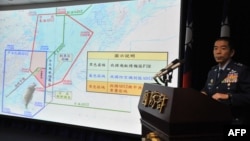An air defense zone declared by Beijing, or any effort to stop civilian ship traffic, would raise the risk of conflict in the disputed South China Sea after years of calm, because either move would inconvenience day-to-day operations, scholars who follow the region say.
Five other militarily weaker maritime claimants have watched without major protest as China tests bombers, holds naval drills and considers nuclear power stations in the 3.5 million-square-kilometer sea. Last week Chinese news media reported tests of the country’s first domestically made seaplane, for possible use in the disputed waterway.
But other governments — Brunei, Malaysia, the Philippines, Taiwan and Vietnam — would step up their protests if Beijing declared an air defense identification zone or began forcibly directing traffic of the numerous privately owned ships that transit the sea, said Alexander Huang, strategic studies professor at Tamkang University in Taiwan.
“It would be a direct confrontation to the principle of freedom of navigation,” he said. “So far, China’s position is that ‘I’m taking control in several spots in the South China Sea,’ but China has never disrupted the freedom of navigation, military and civilian, so far.”
Countries with competing claims now let one another use the open sea as long as vessels from one avoid islets held by the others. Commercial planes overfly the sea around the clock, and at least one-third of the world’s marine shipping passes through it, along with 1.6 million fishing boats.
Air defense identification zone
Beijing has not declared an air defense identification zone (ADIZ) in the South China Sea, but the other countries worry because in 2013 it established a zone in the disputed East China Sea. China said that declaration empowered it to direct air traffic over the waterway claimed in part by Japan and Taiwan, but analysts say the zone has been unenforced.
“I think the move that people believe will be a game changer is an ADIZ for the South China Sea,” said Yun Sun, East Asia Program senior associate at the Stimson Center think tank in Washington. “When ADIZ was first announced for the East China Sea, people have been chasing the Chinese to ask that question.”
China may be holding off any South China Sea air defense zone until able to implement it, Sun said. Tension with the United States, which occasionally passes navy ships through the South China Sea to assert its freedom of navigation, might also motivate China to mothball any ADIZ plans, she added. The two powers are locked in a trade dispute.
The East China Sea zone is more of a “political and symbolic practice,” Huang said.
Beijing calls about 90 percent of the South China Sea its own, citing historical records to back its claim. The sea that stretches from Taiwan to Singapore is prized for fisheries, shipping lanes, oil and gas.
China has reclaimed land in the sea’s Paracel and Spratly island chains and sent military units to some of those newly built artificial islands. Other claimants have said little in recent years as China has stepped up investment and economic aid to its neighbors. China and the Southeast Asian claimants are working this year on a code of conduct to head off maritime mishaps.
Ship traffic control
China has the radars and fleet to control movements of private vessels in the disputed sea, but any such restrictions would anger other countries by squelching income from fishing, shipping and undersea gas exploration, analysts believe. China has made no announcement of this type.
A spike in Chinese military vessels may upset people in the Philippines, for example, as the fishing-intensive country’s president, Rodrigo Duterte, tries to work with China but faces public skepticism about Beijing’s maritime expansion.
“They are trying to assure the public the government is doing something, and one of the areas of course is how the government approaches China,” said Maria Ela Atienza, political science political science professor at the University of the Philippines Diliman. “People will react more when they see military ships in the disputed areas.”
China will probably avoid making new military moves, such as sending an aircraft carrier fleet, to avoid “driving ASEAN into the arms of the United States,” said Alan Chong, associate professor at the S. Rajaratnam School of International Studies in Singapore. Brunei, Malaysia, Vietnam and the Philippines belong to ASEAN, which stands for Association of Southeast Asian Nations.
But non-Chinese fishing fleets could face trouble from their Chinese counterparts or from search-and-rescue boats with government backing, Chong said. Some scholars call these fleets, some backed by coast guard vessels, a “militia.”
“Fishing fleets, humanitarian assistance vessels, these are the ones that are pushing China’s claims,” Chong said. “There is where the militarization is happening, except that it cannot be called militarization.”














